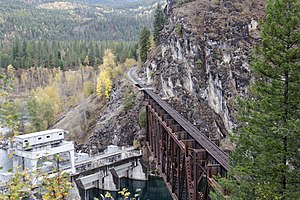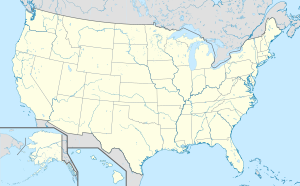Box Canyon Bridge
Coordinates: 48 ° 46 '50 " N , 117 ° 24' 37" W.
| Box Canyon Bridge | ||
|---|---|---|
| use | Railway bridge | |
| Crossing of | Pend Oreille River | |
| place | Pend Oreille County | |
| Entertained by | Pend Oreille Valley Railroad | |
| construction | Truss bridge | |
| overall length | 154 m | |
| Longest span | 85 m | |
| Construction height | 15 m | |
| opening | 1910 | |
| location | ||
|
|
||
The Box Canyon Bridge is a single-track railroad bridge over the Pend Oreille River in Pend Oreille County , Washington . The Pend Oreille runs south to north through the foothills of the Selkirk Mountains in the far northeast of the state and flows into the Columbia River . The bridge is about three miles downriver from Ione and about ten miles upriver from Metaline Falls . The truss bridge was built by the Idaho and Washington Northern Railroad until 1910 , later sold to Milwaukee Road and has been owned by the Pend Oreille Valley Railroad (POVA) since 1979 . The state regional railway company had to shut down the northern part of its route over the Box Canyon Bridge in 2016 due to insufficient utilization .
In the 1950s, the Box Canyon Dam was built at the level of the bridge , and its segment weir is directly below the bridge. The steel bridge has been listed as a historical monument since 1982 by being included in the National Register of Historic Places (NRHP # 82004270).
history
After the large railway companies had completed several transcontinental connections via Spokane to Puget Sound at the end of the 19th century , a large number of branches and smaller railway companies whose routes were connected to the networks of the Northern Pacific Railway , Great Northern Railway or the Union Pacific were created Railroad were connected. East of Spokane, the Idaho and Washington Northern Railroad built in 1907 a 70 km long line in northwest Idaho from what is now Post Falls (McGuire) to Newport . In order to develop the rich pine and cedar deposits in northeast Washington and at the same time gain access to the large clay , limestone and slate deposits , the route along the Pend Oreille River was extended 100 km north to Metaline Falls in 1911 . The transport to the south was difficult and not continuously possible due to the opposite direction of flow of the Pend Oreille and the existing rapids and waterfalls. The railway line had to cross the river between Ione and Metaline Falls, as its course changed from the west bank to the east bank on the last section. In 1910, five kilometers downstream from Ione, a 150 meter long truss bridge was built over the river canyon, which led the track about 40 meters above the water level at the time.
A few years after the expansion was completed, Idaho and Washington Northern ran into financial difficulties and was taken over by Milwaukee Road in 1916 . In the following 50 years the connection along the Pend Oreille flourished, especially with the construction of the many barrages for energy supply along the Columbia and its tributaries, the demand for cement from the Lehigh Portland Cement Company's plant in Metaline Falls increased from the 1930s . At that time, five run-of-river power plants were also built on the Pend Oreille , including the Box Canyon Dam , which was completed in 1956 and whose segment weir is now directly below the Box Canyon Bridge . From the 1970s, the increasing shift of traffic to the road, the utilization of the route decreased and the Milwaukee Road announced in 1977 the closure of the connection from Newport to Metaline Falls. Subsequently, the Pend Oreille County founded the Port of Pend Oreille, a state port authority (Port District) , which acquired the route from Milwaukee Road with financial support from federal funds in September 1979 ; the authority has operated it since then as Pend Oreille Valley Railroad (POVA). At the end of the 1990s, POVA expanded its route south to Sandpoint in Idaho through a lease agreement with the BNSF Railway , but had to stop traffic in the north via Ione and the Box Canyon Bridge to Metaline Falls in 2016 due to the lack of freight transport , including the remaining passenger train North Pend Oreille Valley Lions Excursion Train was affected.
description

The 154 meter long steel structure is divided from the south to the north bank into two truss girders 44 and 85 meters long and a 24 meter long cantilevered solid wall girder . The bridge rests on a free-standing reinforced concrete pillar in the river bed on the south side as well as reinforced concrete bases embedded in the rock walls, which act as abutments at the respective ends . Due to the strongly jagged rock slope, the beam girder on the north bank could not merge directly into the track bed, which made it necessary to erect two small wooden trestle bridges over the next 30 meters . The two trusses are strut trusses with posts . The brackets of an additional solid wall girder , on which the track is guided, rest on the upper chords . In the case of the smaller truss, the lower and upper chords converge towards the abutment, which creates the characteristic triangular shape. In contrast to this, the central beam has parallel straps and a height of 15.2 meters, with a width of 6.7 meters (each related to the central axes of the straps). As the central girder could not be erected from both sides due to the steep canyon, it was decided to mount it in a cantilever from the south side. The smaller, about 270-ton lattice girder served as an anchor girder, which was weighted down with an additional 400 tonnes of railroad tracks and the upper chords of the two girders were connected with eye sticks ; when finished, the central beam weighed around 630 tons.
literature
- Idaho & Washington Northern Railroad. In: Railway Age Gazette. Vol. 45, No. 17, 1908, p. 607.
- The Idaho & Washington Northern. In: Railway Age Gazette. Vol. 49, No. 21, 1910, pp. 959-962.
Web links
- POVA - Box Canyon Bridge. BridgeHunter.com
- Pend Oreille Valley Railroad (POVA). Port of Pend Oreille
- Whitman County Heritage: Box Canyon. Metalines Community Library, Pend Oreille County Library District (historic photos)
Individual evidence
- ^ Idaho and Wash. Northern RR Bridge. National Register of Historic Places, NPGallery Digital Asset Management System; accessed on October 20, 2019.
- ^ Idaho & Washington Northern Railroad. In: Railway Age Gazette. Vol. 45, No. 17, 1908, p. 607.
- ^ A b The Idaho & Washington Northern. In: Railway Age Gazette. Vol. 49, No. 21, 1910, pp. 959-962.
- ^ Eli Francovich: The end of the scenic Ione-to-Metaline Falls train ride will impact the whole North Pend Oreille Valley. The Spokesman Review October 4, 2016; accessed on October 20, 2019.
- ↑ Kit Oldham: Port of Pend Oreille buys a railroad on September 19, 1979. HistoryLink.org Essay 9698, January 26, 2011; accessed on October 20, 2019.
- ^ Idaho and Washington Northern Railroad Bridge. Next Exit History; accessed on October 20, 2019.
- ^ Lisa Soderberg: Idaho to Washington Northern Railroad Bridge. Historic American Engineering Record Inventory, Department of the Interior, Washington, DC October 1979.



